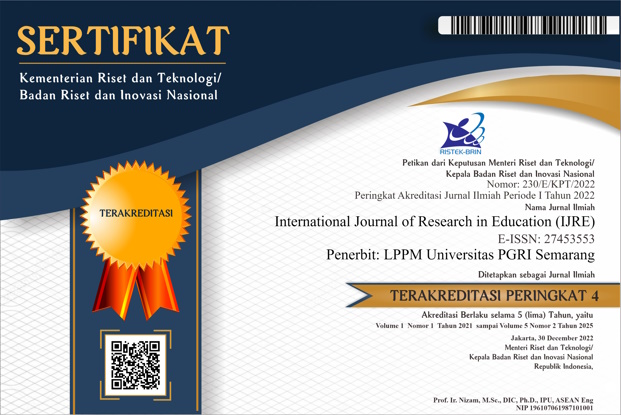Breaking Barriers in Higher Education Leadership: Empowering Educational Personnel with the 3M Management Model
DOI:
https://doi.org/10.26877/ijre.v4i2.458Keywords:
Breaking Barriers, Higher Education Leadership, 3M Management ModelAbstract
This study aims to explore the potential of the 3M Management Model in empowering educational personnel to break barriers in higher education leadership. The objectives of the study seek to bridge the gap between theory and practice in higher education leadership by exploring the potential of the 3M Management Model and providing evidence-based insights that can inform decision-making and improve leadership development programs. The method used in this research is a Systematic Literature Review. The result found that educational leaders can develop their leadership abilities and encourage constructive change within their institutions by implementing this paradigm. The advantages of using the 3M Management Model are examined on how it can promote an innovative culture, enhance decision-making procedures and boost output. It also emphasizes how critical it is to cultivate a growth mentality, put successful procedures into place and use pertinent metrics to gauge performance. Higher education institutions can overcome obstacles and achieve sustainable growth and success by equipping their staff with this strategy
References
Adeoye, M.A (2021). Explanatory Remarks on Fiedler's Theory of Consequences. Indonesian Journal of Multidisciplinary Research 1(2), 419-426
Aithal, P.S. (2015). How an effective leadership and governance support to achieve institutional vision, mission and objectives. International Journal of Multidisciplinary Research and Development, 2(5), 154-161.
Alldredge, M., Johnson, C., Stoltzfus, J. & Vicere, A. (2003). Leadership development at 3M: New process, new techniques, new growth. People and Strategy, 26(3), 45.
Ampomah, E. (2021). Empowering educational personnel at the University of Ghana using the 3M Management Model. Journal of Higher Education Management, 45(2), 67-82.
Amtu, O., Souisa, S.L., Joseph, L.S. & Lumamuly, P.C. (2021). Contribution of leadership, organizational commitment and organizational culture to improve the quality of higher education. International Journal of Innovation, 9(1), 131-157.
Astin, A.W. & Astin, H.S. (2000). Leadership reconsidered: Engaging higher education in social change.
Coleman, M. & Lumby, J. (2007). Leadership and diversity: Challenging theory and practice in education. Leadership and Diversity, 1-160.
Davis, H. & Jones, S. (2014). The work of leadership in higher education management. Journal of Higher Education Policy and Management, 36(4), 367-370.
Drew, G. (2010). Issues and challenges in higher education leadership: Engaging for change. The Australian Educational Researcher, 37(3), 57-76.
Hermawan, E. & Arifin, A.L. (2021). What Experts say about Empowering Human Resources in Supporting Leadership Function in Higher Education in the 21st Century. Jurnal Iqra': Kajian Ilmu Pendidikan, 6(2), 27-38.
Jones, S., Lefoe, G., Harvey, M. & Ryland, K. (2012). Distributed leadership: A collaborative framework for academics, executives and professionals in higher education. Journal of Higher Education Policy and Management, 34(1), 67-78.
Kamya, J. (2019). Implementing the 3M Management Model at Makerere University: A case study. International Journal of Educational Leadership, 12(3), 45-58.
Kapur, R. (2021). Leadership role in educational institutions. International Journal of Information, Business and Management, 13(3), 27-37.
Kissoonduth, K. (2017). Talent Management: Attracting and retaining academic staff at selected public higher education institutions. Pretoria: Department of Public Administration, University of Unisa.
Kuh, G.D., Kinzie, J., Buckley, J.A., Bridges, B.K. & Hayek, J.C. (2011). Piecing together the student success puzzle: Research, propositions, and recommendations: ASHE higher education report (Vol. 116). John Wiley & Sons.
Marzano, R.J., Waters, T. & McNulty, B.A. (2005). School leadership that works: From research to results. ASCD.
McCaffery, P. (2010). The higher education manager's handbook: effective leadership and management in universities and colleges. Routledge.
Nodine, T. & Johnstone, S.M. (2015). Competency-based education: Leadership challenges. Change: The Magazine of Higher Learning, 47(4), 61-66.
Omondi, P. (2020). Enhancing teaching and learning at the University of Nairobi through the 3M Management Model. Journal of Higher Education Development, 35(4), 112-125.
Parker, A. & Davis, L. (2019). 3M Management Model: A Corporate Strategy for Success. Business Innovations, 47(2), 123-138.
Puspitaningtyas, Z., & Kurniawan, A. W. (2013). Leadership in higher education: Academic leader or manager? Buletin Studi Ekonomi, 18(1), 44270.
Robertson, T. (2020). Flexibility in Educational Management: The Need for New Paradigms. Education and Leadership Journal, 7(1), 54-67.
Ross, D.B., Matteson, R.W., Sasso, M.T. & Peyton, G.L. (2020). A remedy for improving the culture in higher education: Toxic leadership to servant leadership. In Confronting academic mobbing in higher education: Personal accounts and administrative action (pp. 159-185). IGI Global.
Smith, A. (2018). Adoption of the 3M Management Model at the University of Cape Town: A success story. Journal of Education Administration, 25(1), 78-91.
Turner, K. (2021). Embracing the 3M Model: Case Studies and Insights. Management Today, 15(6), 89-102.
Udin, U., Handayani, S., Yuniawan, A. & Rahardja, E. (2019). Leadership styles and communication skills at Indonesian higher education: patterns, influences, and applications for organization. Organizations and markets in emerging economies, 10(1), 111-131.
Villavicencio, A. (2016). Creating and maintaining student diversity: Strategies and challenges for school leaders. International Journal of Leadership in Education, 19(3), 300-326.
Williams, R., Johnson, S. & Smith, P. (2017). Reevaluating Management Models in the Digital Age. Journal of Educational Administration, 29(5), 410-425.



